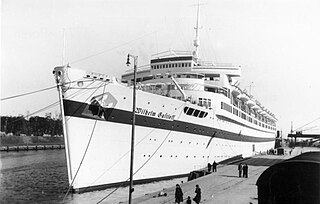
MV Wilhelm Gustloff was a German military transport ship which was sunk on 30 January 1945 by Soviet submarine S-13 in the Baltic Sea while evacuating civilians and military personnel from East Prussia and the German-occupied Baltic states, and German military personnel from Gotenhafen (Gdynia) as the Red Army advanced. By one estimate, 9,400 people died, making it the largest loss of life in a single ship sinking in history.

The Royal Canadian Navy is the naval force of Canada. The RCN is one of three environmental commands within the Canadian Armed Forces. As of 2023, the RCN operates 12 frigates, four attack submarines, 12 coastal defence vessels, eight patrol-class training vessels, two offshore patrol vessels, and several auxiliary vessels. The RCN consists of 8,400 Regular Force and 4,100 Primary Reserve sailors, supported by 3,800 civilians. Vice-Admiral Angus Topshee is the commander of the Royal Canadian Navy and chief of the Naval Staff.

The Tower Hill Memorial is a pair of Commonwealth War Graves Commission memorials in Trinity Square Gardens, on Tower Hill in London, England. The memorials, one for the First World War and one for the Second, commemorate civilian, merchant seafarers and fishermen who were killed as a result of enemy action and have no known grave. The first, the Mercantile Marine War Memorial, was designed by Sir Edwin Lutyens and unveiled in 1928; the second, the Merchant Seamen's Memorial, was designed by Sir Edward Maufe and unveiled in 1955. A third memorial, commemorating merchant seamen who were killed in the 1982 Falklands War, was added to the site in 2005.
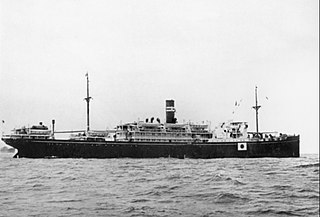
Montevideo Maru was a merchant ship of the Empire of Japan. Launched in 1926, it was pressed into service as a military transport during World War II. It was sunk by the American submarine USS Sturgeon on 1 July 1942, drowning 1,054 people, mostly Australian prisoners of war and civilians who were being transported from Rabaul, the former Australian territory of New Guinea, to Hainan. The sinking is considered the worst maritime disaster in Australia's history. The wreck of the Montevideo Maru was discovered on 18 April 2023.

HMAS AE1 was an E-class submarine of the Royal Australian Navy (RAN). She was the first submarine to serve in the RAN, and was lost at sea with all hands near what is now East New Britain, Papua New Guinea, on 14 September 1914, after less than seven months in service. Search missions attempting to locate the wreck began in 1976. The submarine was found during the 13th search mission near the Duke of York Islands in December 2017.
The National Memorial Arboretum is a British site of national remembrance at Alrewas, near Lichfield, Staffordshire. Its objective is to honour the fallen, recognise service and sacrifice, and foster pride in the British Armed Forces and civilian community.
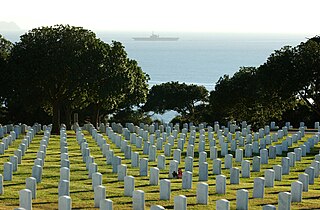
Fort Rosecrans National Cemetery is a federal military cemetery in the city of San Diego, California. It is located on the grounds of the former Army coastal artillery station Fort Rosecrans and is administered by the United States Department of Veterans Affairs. The cemetery is located approximately 10 miles (16 km) west of Downtown San Diego, overlooking San Diego Bay and the city from one side, and the Pacific Ocean on the other. Fort Rosecrans is named after William Starke Rosecrans, a Union general in the American Civil War. The cemetery was registered as California Historical Landmark #55 on December 6, 1932. The cemetery is spread out over 77.5 acres (31.4 ha) located on both sides of Catalina Blvd.

MS Jutlandia was contracted by and built for the East Asiatic Company (EAC) in 1934, as a combined passenger and cargo ship at EAC's Nakskov Shipyard, Denmark. Following an extended operational life in which she also served as a hospital ship and a royal yacht, she was finally decommissioned in 1965.

Nyhavn is a 17th-century waterfront, canal and entertainment district in Copenhagen, Denmark. Stretching from Kongens Nytorv to the harbour front just south of the Royal Playhouse, it is lined by brightly coloured 17th and early 18th century townhouses and bars, cafes and restaurants. The canal harbours many historical wooden ships.

The Rouse Simmons was a three-masted schooner famous for having sunk in a violent storm on Lake Michigan in 1912. The ship was bound for Chicago with a cargo of Christmas trees when it foundered off Two Rivers, Wisconsin, killing all on board.

SS Tuscania was a luxury liner of the Anchor Line, a subsidiary of the Cunard Line and named after Tuscania, Italy. In 1918 the ship was torpedoed and sunk by the German U-boat UB-77 while transporting American troops to Europe with the loss of 210 lives.
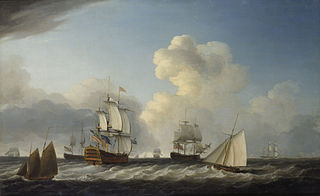
HMS St George was a 98-gun second rate ship of the line of the Royal Navy, launched on 14 October 1785 at Portsmouth. In 1793 she captured one of the richest prizes ever. She then participated in the Naval Battle of Hyères Islands in 1795 and took part in the Battle of Copenhagen in 1801. She was wrecked off Jutland in 1811 with the loss of almost all her crew.

The SS Park Victory was a Victory-class cargo ship built during World War II under the Emergency Shipbuilding program. The ship was operated by the Seas Shipping Company. The ship launched on April 21, 1945, near the end of the war.

Holmen is a water-bound neighbourhood in Copenhagen, Denmark, occupying the former grounds of the Royal Naval Base and Dockyards. In spite of its name, deceptively in singular, Holmen is a congregation of small islands, forming a north-eastern extension of Christianshavn between Zealand and the northern tip of Amager.

Garrison Cemetery is a cemetery in Copenhagen, Denmark. It was inaugurated in 1671 on a site just outside the Eastern City Gate, as a military cemetery complementing the naval Holmens Cemetery which had been inaugurated a few years earlier on a neighbouring site. Later the cemetery was opened to civilian burials as well.
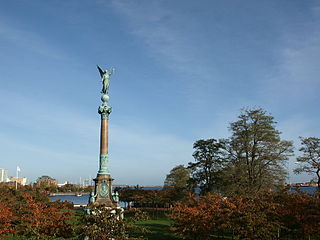
The Ivar Huitfeldt Column is a monument at Langelinie in Copenhagen, Denmark, built to commemorate the death of Admiral Ivar Huitfeldt and his men from HDMS Dannebroge, which exploded and sank in the Battle of Køge Bat during the Great Northern War. The monument was constructed in 1886 to a design by Vilhelm Dahlerup. Ferdinand Edvard Ring was responsible for the statue of the Roman goddess of victory, Victoria, and for the reliefs, while Carl Brummer undertook the monument's architectural design.

Sømandshjemmet Bethel, now known as Hotel Bethel, is a sailor's hostel overlooking the Nyhavn canal in central Copenhagen, Denmark. Today it is mainly used as a residential hotel. The site also comprises a sailor's church.

Christmas Møllers Plads is a major junction located in front of the embankment to Christianshavn on northern Amager in Copenhagen, Denmark. It links Torvegade, the main thoroughfare of Christianshavn, with Vermlandsgade, Amagerbrogade, Amagerfælledvej and Ved Stadsgraven-Amager Boulevard. Its name commemorates the Conservative politician Christmas Møller who had been active in the resistance movement during World War II and later served as Minister of Foreign Affairs.
The Tasmanian Seafarers' Memorial is a public memorial structure located at Triabunna, Tasmania which jointly commemorates all Tasmanians who died at sea, along with the lives of all seafarers of any origin who lost their lives in Tasmanian waters. The memorial comprises individual commemorative plaques for each maritime tragedy involving recreational, commercial, mercantile or naval vessels and personnel lost since 1803. As of February 2017, the memorial contained plaques for 116 events involving the loss of over 1450 lives.

The Maritime Monument, located at Langelinie, close to Langelinie Marina, is a maritime memorial in Copenhagen, Denmark, commemorating civilian Danish sailors who lost their lives during the First World War. The monument consists of a bronze sculpture of a winged female figure, representing Memory, placed on a rhombus-shaped podium with a series of narrative reliefs on its side.


















